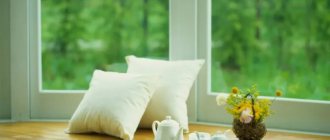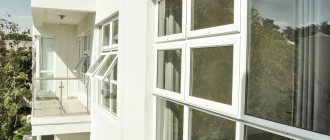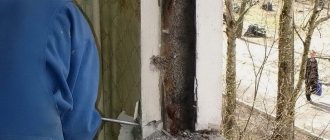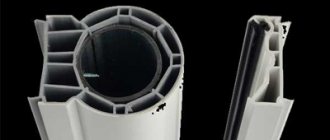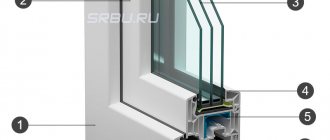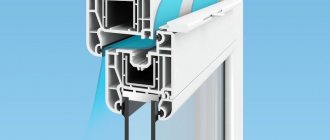How to choose the right profile
When talking about a profile, an analogy is often drawn with the skeleton of a window. This complex structure made of plastic and metal has several cavities - chambers - separated by sealed partitions. Their number affects the strength of the window and its ability to retain heat. Polyvinyl chloride (PVC) is used to make window profiles.
Reasons why this type of plastic is used:
- ability to withstand adverse conditions;
- low thermal conductivity;
- cheapness;
- environmental Safety;
- preservation of consumer properties for a period of at least 50 years;
- reliable sound insulation.
The usual color of PVC is white, but there are multi-colored profiles, as well as laminated ones for different types of wood.
By examining the plastic, you can determine how well the window frame will serve. High-quality PVC is an absolutely smooth, monolithic, homogeneous material. The presence of stains and graininess eloquently indicates a fake.
Profile classes
The quality of windows is determined by the thickness of the outer part of the contour and internal partitions. According to this indicator, profiles are divided into 3 classes:
- Profile A is ideal for residential buildings: the thickness of its external walls starts from 2.8 mm, internal - from 2.5 mm.
- Profile B – suitable for heated and unheated rooms. It has a thickness of external walls from 2.5 mm, internal walls from 2 mm, windows made from it are less adapted to loads.
- Profile C - called object profile, used in rooms without heating. Such windows often do not have opening sashes. The wall thickness is not standardized, but it is usually less than that of other types of profiles.
Metal inserts play an important role - they increase the strength of the structure. Therefore, such windows are sometimes called metal-plastic.
Air chambers
The profiles contain from 3 to 8 internal air chambers, which are needed to protect against cold, street noise, and to enhance the strength of the structure. The ability of a window to keep heat out of a room is correlated with the number of chambers.
- The three-chamber profile is the most commonly used. Suitable for regions with temperate climates, where winter temperatures do not drop below 30 °C. Standard width is 5.8 cm.
- Four- and five-chamber profiles are more expensive and weigh more. Their installation is justified only in cold regions, where they will keep the room warm even in the most severe frosts. They are also chosen for windows that face a busy road due to higher sound insulation.
- Single- and double-chamber products are popular due to their low price. But it makes sense to install windows from such a profile only in the south of Russia, where there are no cold winters.
This is interesting! The thermal conductivity of a profile with 7–8 chambers is lower than that of products with fewer chambers: numerous partitions negate the insulating properties of the air in the chambers. A wide profile with a small number of chambers will retain heat better than a narrow multi-chamber one.
External chambers, thanks to special holes, also serve as condensate drains. They do not affect the quality of thermal insulation and do not spoil the aesthetic appearance of the structure. On the contrary, the absence of technological holes indicates low quality: such a window will last less than the standard period.
Recently, window designs have become widespread, in the chambers of which the air is replaced by foamed heat insulators. They retain heat even better, but the price becomes significantly higher.
Frost resistance
Another profile parameter is frost resistance. It should not change its properties at low temperatures. A frost-resistant profile that is suitable for the domestic climate should be marked “M”. The degree of resistance to adverse conditions can also be seen in the passport.
Profile width
For standard windows, the profile width (installation depth) ranges from 50–80 mm. When it does not exceed 60 mm, the number of cameras in the frame is usually 3, and at 70 mm – 4–5. The greater thickness allows the use of more durable fittings, additional soundproofing and insulation contours, and thick double-glazed windows.
Read about which windows are better, plastic or wooden, here.
Educational video about the secrets of choosing a PVC profile:
Expert advice: for the middle zone, a 3-chamber profile is more than enough. There is no point in overpaying for multi-chamber products that are positioned as warmer: you will not notice the difference. It is better to choose a class A profile; class C is unacceptable in residential premises. And you should always remember that the quality of assembly and installation of the window is more important than the profile parameters.
What is PVC
Polyvinyl chloride (PVC) is a type of thermoplastic. The plastic base can be recycled into a completely new product.
PVC contains 43% ethylene (a product of oil and gas processing) and 57% combined chlorine. It is obtained from ordinary table salt. In its original form, PVC is a powder. Then, depending on the final goal, stabilizers, various additives, additives, modifiers, and coloring agents are added to it. They determine resistance to ultraviolet radiation, water, snow, high and low temperatures, appearance, and other qualities.
The main type of stabilizers is lead in a passive state. Manufacturers, concerned about preserving the environment, are switching to the use of calcium and zinc compounds. To increase the strength of structures, special modifiers are added to the initial composition.
If we talk specifically about vinyl chloride monomers, then for each kilogram of the profile there is no more than 1 mg. They do not evaporate into the external environment either during the manufacture or operation of windows. PVC is a highly flammable material with a tendency to self-extinguish. It is not destroyed by solutions of acids, alkalis, lime, strong detergents, or precipitation.
If we analyze everything that was said earlier, we can conclude that polyvinyl chloride is safe for humans and pets. To make sure of this, it is enough to request a hygiene certificate from the manufacturing company.
Plastic windows of proper quality are allowed for installation in residential and public buildings, educational and medical institutions, and production workshops.
We understand double-glazed windows: type and quantity of glass, markings, spacer frame
A double-glazed window compared to traditional window glass is a complex design. This is a block of glass, hermetically sealed together. The space between the two glass sheets is called the chamber. It should not be confused with those included in the profile.
What does the thermal and sound insulation of a double-glazed window depend on?
The ability to retain heat and keep noise out depends on:
- From the thickness of the glass unit. For a house or apartment, a double-glazed window with a thickness of 32–44 mm is suitable.
- Depending on the number of cameras. Typically, a double-glazed window consists of 3 glasses and 2 chambers between them. For harsh climates or houses located in places with high noise levels, three- and four-chamber packages are produced. Single-chamber ones are suitable for arranging balconies, loggias, and gazebos.
- From the width of each chamber of the glass unit. The larger it is, the better the insulating characteristics. However, after 24 mm, increasing the thickness no longer increases the positive properties of the product.
- From filling the cells. Inert gas pumped between the glasses reduces heat loss and protects against noise and ultraviolet radiation. Argon retains 50% more heat compared to air, krypton - 2 times more than argon.
- From the thickness of the glass. If you install 5 or 6 mm external glass instead of the standard 4 mm in a window facing a busy street, the sound insulation will increase, but only slightly. And glass of different thicknesses will not resonate with each other.
- Depending on the type of glass. It makes sense to choose a material that is more expensive, but with additional useful properties. Low-emissivity glass that reflects infrared rays keeps your home warm in winter and cool in summer.
Advice from Mr. Build. Sometimes there is no point in spending money on extra glass: you can put single-chamber double-glazed windows on the external block of the balcony, and the internal block will protect from noise and cold. For comparison: full glazing of a 3-room apartment with three-chamber double-glazed windows will cost 75,000 rubles, and if you install single-chamber double-glazed windows on the balcony, the total cost will drop to 71,250 rubles.
Glass types
To obtain low-emissivity glass, a thin metal film is sprayed onto it.
- K-coating is a tin film that reduces heat loss by 25% in a single-chamber double-glazed window.
- I-coating (i) is a layer of rare earth metals that retains more than 30% of heat. It is installed only from the room side, the coating is turned inside the chamber, since it is not resistant to mechanical damage. Often labeled E-low.
USEFUL INFORMATION: Which sealant is better for plastic windows: inside and outside
Due to such glass, a single-chamber double-glazed window approaches the thermal insulation properties of a double-chamber one and can even exceed them.
If you listen to the recommendations of experts in the field of energy saving, then the best choice in terms of heat conservation will be a two-chamber double-glazed window filled with an inert gas and having one glass with a special coating. Thermal packages will help you save on heating in winter and on electricity due to less frequent use of air conditioning in summer.
Let's look at an example. Ordinary double-glazed windows for a private house cost the owner 150,000 rubles. In winter, you have to pay 8,000 rubles for heating. per month, and in the summer, due to the operation of the air conditioner, you need to pay 600 rubles more for electricity. per month. If the owner of the house installed thermal packages, he would pay 180,000 rubles for them. But at the same time, heating costs would drop to 4,800 rubles. per month, and for air conditioning – up to 420 rubles. It turns out that thermal packages pay for themselves in two years, and then bring benefits.
It is practically impossible to break glass laminated with triplex. The same quality is found in glass reinforced with special metal or polymer meshes.
INTERESTING FACTS!
- Energy-saving i-glass was invented completely by accident. Japanese scientists were researching the development of protective equipment against radiation and found that some metals applied to glass reflect heat. First, this technology found application in space developments, and is now used in the manufacture of double-glazed windows.
- Scientists still have not been able to explain one amazing phenomenon. After 39 years of operation of a plastic window, the outer wall of the profile becomes 0.75 mm thinner. Not a single version explaining this fact has yet been recognized as sufficiently reliable.
- Triplex laminated glass was also created by chance. The famous French scientist Edward Benidictus dropped a glass flask on the floor. It cracked, but did not shatter into fragments. And the reason for this was a mixture of cellulose nitrate, which froze on the walls of the burst flask and created a layer that prevented the glass from disintegrating.
Glass unit markings, tables
The structure of a double-glazed window can be understood by the markings, which indicate the thickness of the glass, the width of the chambers, and the type of coating. For example, the designation 4-12Ar-4-12 Ar-4I is deciphered as follows:
- double-glazed window;
- glass thickness – 4 mm;
- the distance between them is 12 mm;
- I-type inner glass;
- the chambers are filled with argon.
The following tables will help you choose the ratio of glass unit parameters.
Distance frame
The frame between the glasses sets the distance between them, which ranges from 6 to 24 mm. Frames are made from aluminum, steel, and plastic. Distance frames made of stainless steel or plastic conduct heat to a lesser extent and prevent the formation of a cold bridge, therefore they are considered the best option.
The second function of the frame is moisture absorption. It has an absorbent inside that absorbs liquid, preventing windows from fogging up in winter, and there is perforation on the surface.
Rules for choosing double-glazed windows
To choose reliable double-glazed windows, you need:
- Make sure that there is a marking with the manufacturer’s logo, production date and information about components. Its absence is a reason for serious suspicion.
- Inspect the glass for chips and cracks.
- Check the quality of sealing. There should be no traces of liquid sealant along the bar that regulates the distance between the glasses. The outer layer of the product should look smooth and neat. Sagging and cracks indicate unreliable quality of the package.
- Use a tape measure to determine the accuracy of the geometry. The difference in measurements along the diagonals (more than 3 mm) proves that the glass unit parameters do not meet the standards. The thickness of the package, measured with a caliper, cannot differ from the declared thickness by more than 1 mm.
- Use a square to measure the displacement of the glass planes. A deviation exceeding 1 mm indicates non-compliance with standards.
- Determine the transparency of the glass, the presence of water and steam in the chamber.
Decorative and functional elements
To give the window a more sophisticated look, so-called sprats are used (see photo).
They can vary in color, thickness, and be located between the glasses or on top of them.
Built-in blinds can be a convenient addition to the window design. They are located directly in the glass unit chamber and are controlled from the outside. But such a system has a serious drawback - the impossibility of maintenance and repair.
Read about choosing blinds for plastic windows in this article.
It is much more profitable to order all additional fittings and accessories at once: this way you will not have to pay for their delivery and installation, which will cost from 1,300 rubles.
Which glass unit is warmer?
This table shows how the level of thermal insulation of a double-glazed window increases with the increase in the number of glasses and the thickness of the chambers:
| Double-glazed window formula | Reduced heat transfer resistance coefficient, m2×°C/W |
| 4M1-12-4M1 | 0,30 |
| 4M1-Ag12-4M1 | 0,32 |
| 4M1-16-I4 | 0,59 |
| 4M1-Ar16-I4 | 0,66 |
| 4M1-10-4M1-10-4M1 | 0,47 |
| 4M1-12-4M1-12-4M1 | 0,49 |
| 4M1-Ar10-4M1-Ar10-4M1 | 0,49 |
| 4M1-Ar12-4M1-Ar12-4M1 | 0,52 |
| 4M1-12-4M1-12-I4 | 0,68 |
| 4M1-16-4M1-16-I4 | 0,72 |
| 4M1-Ar6-4M1-Ar6-I4 | 0,64 |
| 4M1-Ar10-4M1-Ar10-I4 | 0,71 |
| 4M1-Ar12-4M1-Ar12-I4 | 0,75 |
| 4M1-Ar16-4M1-Ar16-I4 | 0,80 |
Please note: from the point of view of heat conservation, a single double-glazed window with I-glass is superior to a regular double-glazed one.
Wooden windows
For the manufacture of modern wooden windows, pine or larch are mainly used. These rocks are the most accessible, relatively easy to process and have all the necessary qualities for creating reliable, warm and weather-resistant structures. More expensive options are made from hardwood: oak, ash or meranti.
Wood species (from left to right): oak, larch, pine
The main advantages of wooden glazing are the visual appeal of the natural material, environmental friendliness, high level of thermal insulation and noise absorption. Wood practically does not freeze, is quite resistant to mechanical damage (especially hard wood), and if any defects appear over time, they can be easily eliminated yourself.
The weaknesses of wooden windows are largely related to the naturalness of the wood. They are prone to moisture accumulation, the formation of fungus, mold accumulations, the appearance of various microorganisms or bugs and subsequent rotting. However, thanks to modern processing technologies, the described disadvantages are becoming less and less common, which does not have the best effect on the main advantage of wood - its natural naturalness and environmental friendliness.
Read more about modern wooden windows here
Double-glazed windows for residential premises: minimum and optimal parameters, price comparison
The formula for a double-glazed window suitable for an apartment or house located in central Russia:
- Minimum parameters: double-glazed window 4-10-4-10-4. This is a generally accepted standard with good sound and heat insulation characteristics.
Advice: if you live in a quiet area, it will be more profitable to order a single-chamber double-glazed window with I-glass. It is not as good in terms of sound insulation, but retains heat much better than the standard two-chamber option (see table below).
- Optimal parameters: double-glazed window 4-16Ar-4-14Ar-I4. There are all the necessary additions: wide chambers of different thicknesses for better noise protection, argon filling, energy-saving glass.
USEFUL INFORMATION: The best way to finish the slopes of plastic windows: 4 options, expert opinion
Now let’s compare the cost of these double-glazed windows using the example of products from the Moscow Window Plant:
| Type of glass unit | Marking | Reduced heat transfer resistance coefficient, m2×°C/W | Price, rub./sq. m |
| Standard two-chamber | 4-10-4-10-4 | 0,47 | 2884 |
| Single-chamber energy-saving with I-glass | 4-16-I4 | 0,59 | 2382 |
| Two-chamber energy-saving with argon and I-glass | 4-16Ar-4-14Ar-I4 | 0,77 | 3944 |
A three-chamber double-glazed window is expensive and weighs a lot. It is often proposed to be installed as a “super-warm” option, but its installation in a region with a temperate climate does not make sense: a two-chamber one will be quite sufficient.
Dormer windows
When designing roof window openings, as well as when ordering them, the following points should be taken into account:
- The length of the block should not exceed half the length of the roof slope into which the glazing will be installed;
- The area of translucent filling in the room must be at least 10% of its square footage;
- The lower edge of the block must be located at a level sufficient to view not only the sky, but also the street;
- Since roof windows are located on the roof, it is worth paying special attention to their tightness;
- All the heat in the room rises and accumulates at the top, in the immediate vicinity of the attic block, and if its thermal insulation characteristics are insufficient, heating costs may be unreasonably high;
- Sound absorption is also essential: during heavy rain or hail, the noise of the precipitation can create noticeable discomfort.
How to choose seals
Without seals, it is impossible to seal double-glazed windows and close the window tightly. They are made from rubber, thermoplastic, thermopolymer and silicone.
- Rubber seal is the most inexpensive, but also short-lived. Cracking from heat and frost. It's easy to replace, it's always on sale.
- Thermoplastic (TPE) is the most common because it is suitable for use on automatic assembly lines. It has excellent characteristics, but with frequent opening and closing of the window it quickly wears out, as it becomes brittle from temperature changes. It's inexpensive and easy to change.
- Thermopolymer (ethylene propylene rubber, EPDM) is a more resistant material. Suitable for expensive and moderately expensive windows. It is advisable to call a professional to replace it.
- Silicone is the best sealant. Does not wash out, does not deform, is resistant to temperature changes and cleaning agents. But it is expensive and difficult to find on sale.
Expert advice: the service life of the seals can be extended by regularly (2 times a year in the off-season) cleaning them and lubricating them with silicone oil or glycerin.
Which fittings should I choose?
Fittings for heavy, constantly opening and closing windows must be durable and reliable. Otherwise, the handles will break, and the sashes will sag and jam. The brands Winkhaus, Siegenia Aubi, Roto, GU, Maco have earned trust. High-grade steel with anti-corrosion coating is used for the manufacture of fittings. Polymers are allowed only for plugs and decorative covers.
The best fittings are those that can withstand 50–60 thousand cycles and have a 10-year warranty. The cycle consists of 4 actions: opening for ventilation, closing, swing opening followed by closing.
When purchasing, you should choose adjustable fittings that will allow you to open the sash as needed, and special stoppers will prevent involuntary slamming. Owners of private houses, ground-floor apartments, and summer cottages prefer windows with anti-burglary devices that will prevent intruders from entering. If desired, the fittings are supplemented with details that provide:
- slot ventilation;
- turning limitation;
- functioning of the microlift:
- sash tilt in several positions;
- restricting children's access and other functions.
Expert advice: choose fittings only with the functions you need. Make sure that the extras you pay top dollar for (high-quality European fittings are expensive) are what you actually need. For example, anti-burglary devices are unlikely to be useful on upper floors.
Selecting the opening method
Window designs differ on this basis:
- Deaf - installed in rooms that do not need ventilation, or combined with opening doors.
- Pivot - allow the doors to open in one direction.
- Tilt-and-turn - have two ways of opening: they turn inward, and can also recline, which is important when there is a small child in the apartment or the window sill is filled with flowers. This is a rational option for a kitchen that requires regular air exchange. With a combination of folding and rotating mechanisms, it is convenient to ventilate the room at any time of the year.
- Rotating around its axis - this type is good for large windows; it is equally easy to wash the outer and inner window surfaces.
Expert advice: in a wide window there is no need to make all the sashes openable. The price of such a window will be unreasonably high. Usually one moving element is enough.
Let's look at an example of balcony glazing. A tilt and turn door costs 12,500 rubles, a tilt and turn door costs 11,200 rubles, a swing window costs 10,750 rubles, and a blind window costs 5,900 rubles. If the inner window and two outer ones are rotary, and two more outer ones are tilt-and-turn, you will have to pay 67,150 rubles for everything. And if you make an internal window and three external ones blind, and only one external one - tilt-and-turn, full glazing of the balcony will cost much less - only 44,900 rubles.
Selection of double-glazed windows
More than 80% of the window area is glazing, so the correct choice of double-glazed windows largely affects the characteristics of the window as a whole. Modern windows are equipped with one, two or three-chamber double-glazed windows. The latter option is currently relatively rare, since its cost is quite high, and its important characteristics are not significantly superior to their two-chamber counterparts.
Single-chamber products are more suitable for non-residential buildings or glazing balconies, and are practically not used in private houses or apartments. The most optimal is the installation of double-glazed windows, the characteristics of which depend on the properties of the glass, the size of the interglazed frame and the filling of the chambers.
The distance between the glasses should not be less than 16 mm, at the same time, excessively large gaps increase heat loss due to convection. The glass thickness for internal sheets is in the range of 4-6 mm, for external sheets - up to 10 mm or more, if we are talking about large double-glazed windows. Dried air is used to fill the chambers in budget windows, but the most energy-efficient option is an inert gas (argon or krypton).
High sound insulation performance is achieved by using glass of different thicknesses located at different distances. However, only high-frequency sound is well absorbed, and low frequencies, such as train noise or thunder, are much worse.
Which plastic window manufacturer is better?
Competition and strict control in the window market have driven out outright marriage. But experts unanimously lean towards large manufacturers. They have equipment that smaller companies don't have, so their products are of higher quality. Experts have learned to cope with unwanted linear expansion of PVC, low elasticity coefficient, and improve resistance to temperature changes. Additives and stabilizers for these purposes are strictly controlled and do not cause harm to health.
Which company should you choose?
A list of the best window profile manufacturers, compiled based on ratings and reviews.
Veka
Leads in number of sales, in the top three in all ratings. The technical base allowed the company to finally stop producing low-grade products; only class A profiles are produced. Window models are diverse, durable, known for their reliable noise and heat insulation, tightness, and are equipped with a rubber seal that is not afraid of frost. Disadvantage - they are a bit expensive.
KBE
The company uses environmentally friendly plastic, the windows are durable, have good noise and heat insulation, cope with temperature changes in the range from -50 to +50 °C, and do not fog up. Disadvantages: high price, over time the plastic develops a yellowish tint.
Rehau
The products are distinguished by their environmental friendliness, wide range, durability, sound and heat insulation that meets the requirements of the time, and frost resistance. Disadvantages: reduced height of the sashes, higher cost than other brands.
We recommend paying attention to Rehau windows made from the BLITZ New profile with an installation depth of 60 mm. This is an energy-saving, affordable and high-quality solution. Three-chamber profile, with the ability to install double-glazed windows up to 32 mm. Retains 30 times more heat than wooden Soviet frames. Noise reduction up to 40 Rw dB and excellent appearance.
SALAMANDER
High-strength sealed profiles for all climatic conditions made of perfectly white plastic. All load-bearing walls are made according to RAL class A, the declared service life is up to 45 years. The company's factories are located in Germany, Poland and Belarus.
Proplex
The windows are made using Austrian technology, adapted to the Russian climate, and designed for long-term use. They are inexpensive, the plastic is durable and does not turn yellow. Disadvantages: there is no international certification, the design solutions of some models are below the level of recognized brands.
USEFUL INFORMATION: Panoramic window: in an apartment and a private house, pros and cons
Montblanc
Windows of different types, attractive, inexpensive. Durable, adapted to Russian weather. Disadvantages: there is no quality management certificate, the fittings are rather weak, the seal emits a chemical smell.
LG Chem
A combination of decent heat and sound insulation characteristics and professional design. Glossy plastic, reasonable quality/price ratio. A relative disadvantage is the recent entry into the market in the central part of the country, which affects its popularity.
Trocal
Windows have a deformation-resistant design, designer finds and a large selection of reliable and sealed models that attract buyers. Disadvantages: heavy profile; built-in blinds break after several years of use.
Russian windows
Russian plastic windows are cheaper than foreign ones. But this does not mean low quality. Typically, domestic manufacturers use German technologies. The cost is more affordable due to cheap energy resources and labor. You also need to remember this when choosing.
For example, the Russian company Kaleva works according to a full cycle scheme: from the moment of window design to installation. This is not a common occurrence. It has been operating in the plastic window market from St. Petersburg for more than 20 years. Its PVC profiles are distinguished by their quality, the right balance of rigidity, reliable insulation, and aesthetic appearance.
Which profile for plastic windows did you choose?
Decorated windows
For decorating plastic window structures, there are several common solutions that make it possible to decorate almost any type of glazing without radical changes to the block.
Layouts
Depending on the type of installation, internal and external layouts are distinguished:
- External. They are located on the outside of the glass unit and in most cases are a thin metal profile fixed to the outer glass. The use of this type of decor allows not only to decorate a monotonous structure, in which solid glass predominates, but also to increase its rigidity and ability to absorb sound waves.
- Internal. Mounted directly into a double-glazed window, they have all the positive qualities of external analogues, while allowing the implementation of quite complex design solutions, for example, patterned inserts made of aluminum profiles.
Laminated windows
One of the most common ways to make a PVC structure of the required color or texture is lamination. This is a technology for covering a plastic profile with a special polymer film, the appearance of which is determined by the sample selected from the catalog.
Next, in the video, we talk about just such windows:
Arched windows
Rectangular windows are most often installed in a private house, however, if the building has a specific design or architecture, it is possible to install structures of non-standard shapes, for example, arched ones. When choosing arched windows for glazing, special attention should be paid to profile reinforcement, since there are manufacturers whose profile systems do not provide stiffening elements for curved products, which negatively affects the strength of opening sashes.

